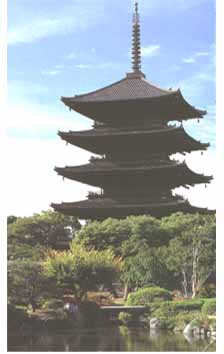| About Us | Site Map | Contact Us |
|
|
| Home | Schools & Teachings | Dharma Centers | Buddha & Bodhisattva Directory | Cosmos |
|
|
The Japanese Buddhist Schools and Teaching
Shingon School
|
The rituals connected with the three secrets are passed orally from teacher to disciple in Shingon; this represents a considerable difference from the schools of Buddhism intended for the general public. According to the view of the Shingon school, these esoteric teachings were expounded as absolute truth by Vairochana, the cosmic buddha, and only the initiated can learn to understand them. Vairochana, who is the central buddha of the school, is the universe itself, without beginning or end. He manifests himself through the perfect harmony of the six elements: earth, water, fire, air, space, and consciousness. According to the teaching of this school, the true meaning of the esoteric teachings cannot be conveyed in words but only through artistic representations. This explains the importance of mandalas in Shingon. |
|
The Shingon school does not, however, despite its esoteric character, deny the importance of our world and of happiness in the present life. From the correct performance of the various rituals, immediate material benefits can be drawn. This view tended to favor the arising of superstitious practices and various currents within Shingon have opposed this. The Shingon school is still today one of the largest Buddhist schools of Japan. __ The "secret of body" finds expression in various hand gestures (mudra), meditation postures, and the use of certain ritual implements, such as vajra or lotus, that are associated with one or another buddha or bodhisattva being invoked. The "secret of speech" is related to the recitation of mantras and dharani; the "secret of mind," to the "five wisdoms," which make the comprehension of reality possible, and to samadhi. Through particular rituals, which are rooted in these three secrets, a connection between the practitioner and a particular buddha is brought about, through which the state of Buddha in me, me in buddha" can be realized; i.e., buddhahood can be attained in this lifetime. The two mandalas important in Shingon are the garbhadhatu mandala and the vayradhatu mandala. The first ("womb" mandala) symbolizes the matrix of all things, the principle that is the basis of everything, and represents the static aspect of the cosmos. In the middle of this mandala is Vairochana, sitting on a red lotus blossom on the eight petals of which are the four transcendent buddhas and bodhisattvas. The vajradhatu mandala (mandala "of the diamond realm") symbolizes the active aspect of the cosmos, the wisdom of Vairochana, which arises from the above "principle" and is its spiritual expression. In the center of this mandala also is Vairochana. He sits on a white lotus blossom with the four transcendent buddhas around him. The realms of the two mandalas cannot exist apart from one another. In an important ceremony of this school, the student must throw a flower onto the mandala and thereafter particularly venerate that buddha on which his flower falls, considering him as his spiritual guide. Other important rites are the ceremonies of abhisheka and ordination. (excerpted from "The Encyclopedia of Eastern Philosophy and Religion", Shambhala, Boston) |
| About Us | Free Books | Site Map | Contact Us | ||
| Copyright © 1999-2020 Manjushri. All Rights Reserved. | ||

 The school of esoteric Buddhism was founded by Kukai (Kobo Daishi), 774-835. Kukai studied the teachings of the
The school of esoteric Buddhism was founded by Kukai (Kobo Daishi), 774-835. Kukai studied the teachings of the